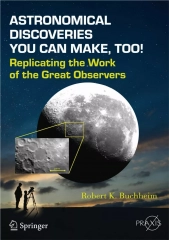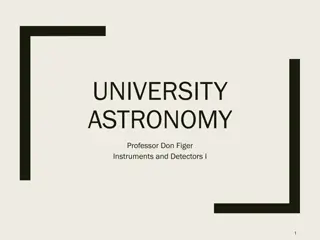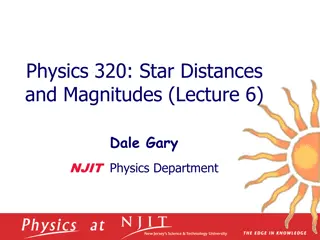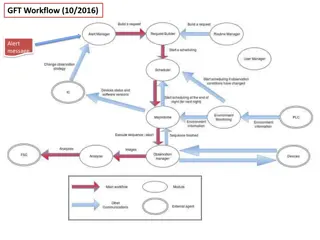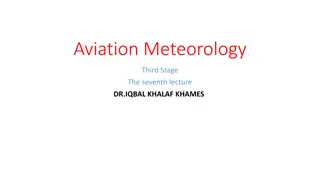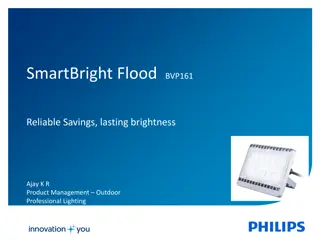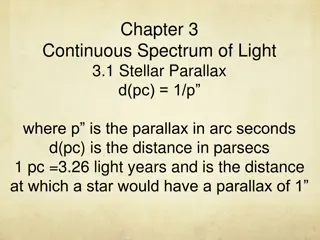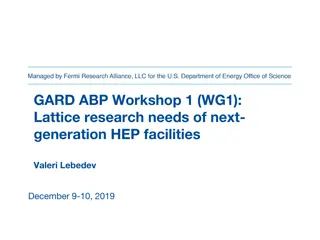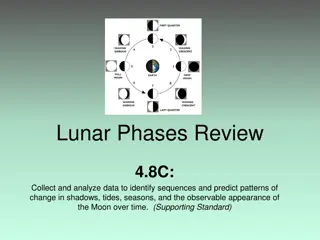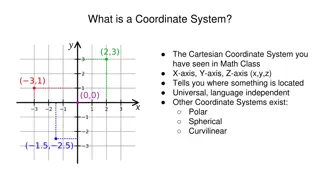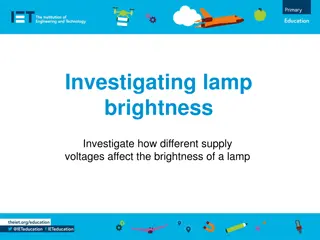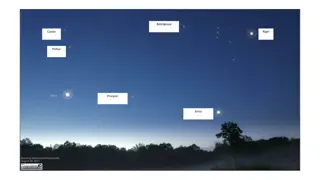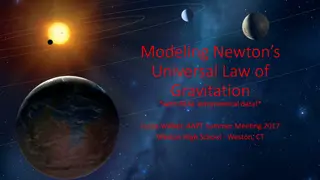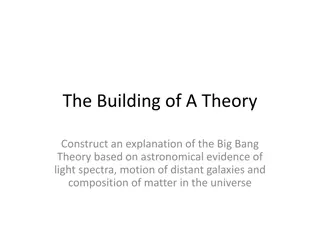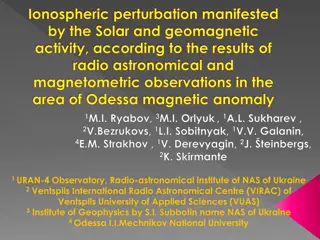Understanding Astronomical Visibility and Brightness Factors
Explore the factors influencing astronomical visibility, such as telescope size, aperture, and light pollution. Learn about the visual systems affecting our ability to see in different lighting conditions and understand concepts like illuminance, luminance, and apparent magnitude in astronomy.
Download Presentation

Please find below an Image/Link to download the presentation.
The content on the website is provided AS IS for your information and personal use only. It may not be sold, licensed, or shared on other websites without obtaining consent from the author. Download presentation by click this link. If you encounter any issues during the download, it is possible that the publisher has removed the file from their server.
E N D
Presentation Transcript
What Will I See? Modelling astronomical visibility Dr Andrew Crumey Northumbria University
Things people ask What should I be able to see with my telescope? What if I get a larger one instead? How much aperture do I need to see galaxies clearly? Should I buy a big telescope and put it in my light-polluted garden, or a smaller one I can take to a dark site?
The Great Chain Sky Telescope Visual system
What will I see? Depends on the sky Depends on the telescope Depends on the visual system
We see because of contrast Colour Brightness
The visual system Photopic (daylight). Uses cone cells on retina. Sensitive to brightness and colour. Scotopic (dark night). Uses rod cells. Sensitive only to brightness. In low light levels we are all colour blind. Mesopic (twilight, light polluted). Uses both rods and cones. Able to distinguish colours. If we can see colour through a telescope we are using mesopic vision. When viewing very faint ( threshold ) targets at a dark site we use scotopic vision.
What do we mean by brightness? The more distant lamp gives us less light. But we do not perceive the lamp itself as being dimmer, just smaller. It has less total brightness but the same brightness per unit area .
Two kinds of brightness The illumination we receive from the source: illuminance. The brightness per unit area of the source itself: luminance. Illuminance decreases with distance. Luminance stays the same. In astronomical terms, illuminance corresponds to apparent magnitude. Luminance corresponds to surface brightness.
Photometry Unit Astronomy Unit Illuminance lx Apparent magnitude mag cd/m2Surface brightness mag/arcsec2 Luminance
Apparent magnitude depends on distance (the further the source, the fainter the magnitude). Surface brightness is independent of distance. A telescope makes things look closer (bigger). It can make things brighter in apparent magnitude. It cannot increase surface brightness (in general it decreases it).
If we try to read in low light we need larger print. For something to be visible at low light levels it needs to be large enough. If we want to see a faint galaxy against the sky we need to magnify it sufficiently.
What a telescope does The telescope captures more light than the naked eye (because of its larger aperture). This means the illumination from a source (illuminance or magnitude) is greater once it has passed through the telescope. The target looks larger. But the luminance (surface brightness) of the source is not increased. In general it is reduced.
Stars Stars are point sources. A telescope does not make stars look bigger (as long as magnification is not excessive). It just gives us more illumination from them (makes them look brighter). But the telescope magnifies the background sky, reducing its surface brightness (making it look darker). So stars have greater contrast and become more easily visible.
DSOs (galaxies, nebulae) DSOs are extended sources. A telescope makes them look bigger, giving us more illumination. But their luminance (surface brightness) is in general decreased. The same thing happens to the background sky. So the contrast of the target against the background is unchanged. But at low levels, objects need to be large enough in order to become visible. If we can make the target big enough, without reducing its surface brightness too much, then it will be visible.
Example 1 Suburban site. M31 is visible in binoculars but not naked eye. Reason: M31 and the sky both have a certain luminance (surface brightness), hence some value of contrast (call it C). Seen through binoculars, the contrast is still C. But the binoculars make the galaxy large enough to be visible.
Example 2 Dark site. M31 is easily visible to the naked eye. Reason: M31 has the same luminance (surface brightness) that it always has, but the sky is darker, so there is a bigger contrast (call it C ). At that contrast level it does not need to be so large to be visible. It is already big enough to be seen with the naked eye.
What this is telling us If we want to look at DSOs then the most important thing is the object s contrast against the sky. The object s luminance (surface brightness) is fixed, the sky s isn t. So the most important thing is the brightness (darkness) of the sky.
Aperture is not king No telescope, no matter how big the aperture, will show galaxies in daylight. But if the sky is dark enough we can see galaxies easily, even without a telescope if they are large enough. A telescope just makes them bigger. If the telescope is big then it enables us to magnify more, without too much loss of surface brightness. So a big telescope will show more galaxies (and details in galaxies), as long as the sky is dark enough to begin with.
The general rule At any given site, a larger scope beats a smaller one at showing faint targets. But a small scope at a dark site will generally beat a larger one at a brighter site. For visual astronomy it is often better to spend money on petrol rather than aperture.
Modelling visibility Hecht (1934): theoretical formula for faintest point source visible against a given background brightness. Based on theory of retinal chemistry. Knoll, Tousey and Hulbert (1946): laboratory experiments where subjects looked at artificial stars. Hecht (1947): showed his formula fitted the data rather well.
Schaefer (1990) used Hechts formula as a model of stellar limiting magnitude. It is the basis for most online calculators. But Hecht s theory of vision was incorrect. His formula was not very accurate. Schaefer made some errors. So a better model is needed.
A better model Hecht (1947) Crumey (2014)
Hechts model only applied to point sources (stars). Need a model that would also apply to extended targets (DSOs). Blackwell (1946) obtained laboratory data for subjects viewing uniform discs against backgrounds at different brightness levels. Various people have tried to model that data and apply it to astronomy, e.g. Clark (1990), Garstang (1999). Those models have problems.
Constrast threshold as a function of target area. Figure from Crumey (2014) showing my model (dotted curves) against the data of Blackwell (1946). Each curve is for a different background level, ranging from bright daylight (bottom) to darkest night (top).
The formulas for these curves are messy, but they are based on a simple finding to do with Ricco slaw . Ricco s law says that for faint targets (near threshold), it is hard to distinguish extended sources from point ones. So for example, a faint star might be mistaken for a small DSO, or vice versa. I found a formula for Ricco s law as a function of background luminance, and this gave me a way of constructing my general model.
But I also wanted to apply my model to telescopic viewing. That meant I had to modify my (messy) formulae to take account of the change of size and illuminance that a telescope introduces, as well as light loss etc. I tested my model against visual observations by professional astronomers.
Test 1: Bowen (1947) He was director of Mount Wilson Observatory. He found his own limiting magnitude for stars viewed through three telescopes at different magnifications. By fitting my model to the data for one telescope I was able to work out unknown parameters such as sky brightness, acuity, eye-pupil size, telescope transmittances. I found it most useful to work in terms of exit pupil rather than magnification.
Exit pupil The disc of light cast on the observer s own eye. Exit pupil diameter = aperture/magnification Graph of stellar limit has three sections: 1. Exit pupil > eye pupil diameter 2. Exit pupil < eye pupil diameter 3. Final limit: either the background is so dark as to be effectively zero, or else magnification renders stars no longer point-like.
Deductions Bowen s pupil diameter: 5.2mm (consistent with age 49 years) Bowen s naked-eye limit: 5.58-5.66 mag Seeing: 1.1 arcsec 60-inch mirror reflectance: 85% Background sky: 21.27 0.06 mag/arcsec2. Zenith sky: 21.6 mag/arcsec2 approx.
Test 2: William Herschel I searched Herschel s papers for details about his observing methods, telescope, measurements etc. This enabled me to predict his telescopic threshold curve using my model. I collected modern astrophysical data on Herschel s catalogue of approximately 2500 DSOs. I plotted surface brightness against angular size, to compare the data with his predicted threshold curve.
Herschel data Eye pupil: 0.2 inches (5.08 mm) Naked-eye limit: 5.9-6.1 mag Telescope aperture: 18.7 inch Magnification: 157 Telescope transmittance: 63.8%
= 23.18 4.167log(0.4680.6 + 1) 2136 objects plotted 92% lie below the curve
10x50 bins dark site SQ 21.5 6-inch refractor dark site SQ 21.5 exit pupil 3mm 16-inch reflector, light polluted site SQ 20 exit pupil 3mm Data points are Messier galaxies in Virgo Cluster
Dark-Sky Classification Perceptual: Limiting magnitude Bortle scale (9 levels) Instrumental: IDA (bronze/silver/gold)
Proposal For the purposes of astronomy... A dark sky is one in which the Milky Way can be seen; An excessively bright sky is one that does not allow for fully scotopic vision.



